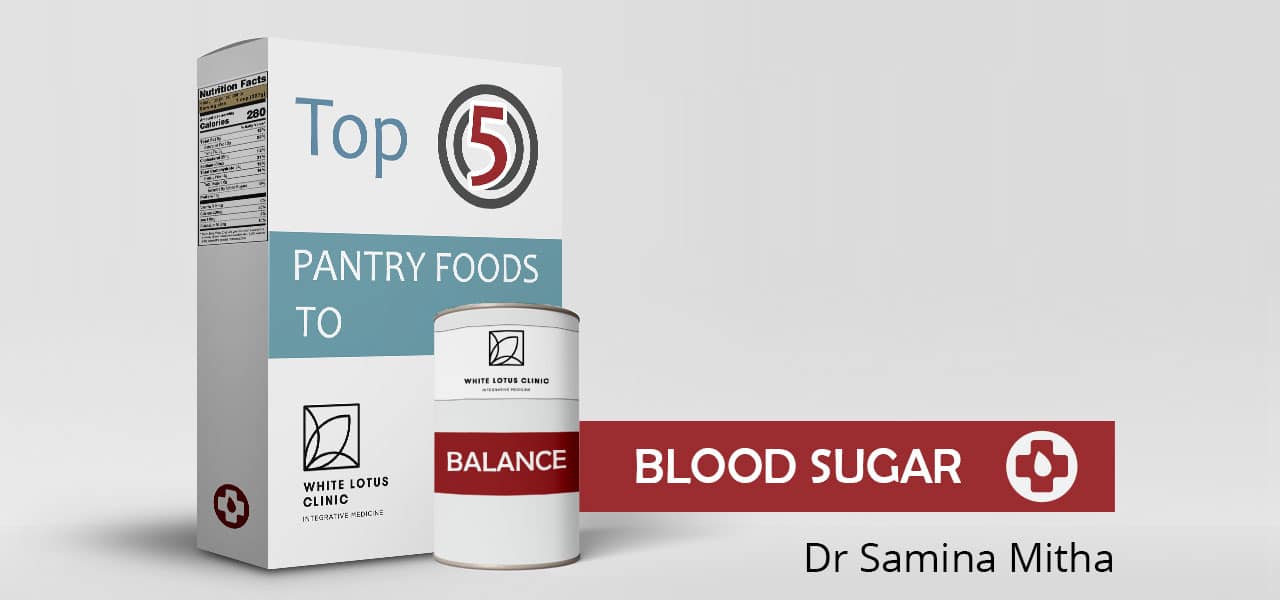Most of the stuff we pack away into our pantries and cupboards are forgotten about until we need them. But did you know that some common spices and pantry ingredients are known to balance blood sugar levels? Let’s take a look at five of the most common ones, and how you can use them!
Cinnamon

This popular spice has been used by people for food and medicine for thousands of years. There are two kinds of cinnamon: Ceylon and Cassia. The latter is more commonly found in grocery stores and is stronger in both scent and flavour of the two species. Ceylon comes from Sri Lanka and is milder and sweeter in taste.
Cinnamon has been studied extensively for its use in managing blood sugar. One study involving individuals with Type 2 Diabetes tested either 1 gram, 3 grams, or 6grams of Cassia cinnamon daily for 40 days versus a placebo. What they found was that any of the cinnamon daily dosages reduced glucose, triglycerides and LDL (aka bad cholesterol) in the study group. [4] This suggests that adding even 1 tsp of cinnamon to your daily food intake could be helpful in managing blood sugar levels.
I love to add cinnamon to my smoothies. It warms the smoothie up and gives it a great flavour!
Flaxseeds

Flaxseeds, also known as Linum usitatissimum, are small brown seeds that contain a nourishing oil. These plants originated in the Middle East have been used by us for thousands of years.
Flaxseeds are extremely beneficial as they contain a high content of healthy omega 3 fatty acids. They’re also high in fibre, and rich in lignans—known as a phytochemical. Lignans are a phytoestrogen and can ultimately have a modulating effect on the body’s estrogen receptors.
Eating flaxseed daily can help to improve blood sugar levels. In this study, they found that consuming 13 grams of ground flaxseeds—approximately 1-2 tablespoons—resulted in reduced glucose and insulin. It also improved insulin sensitivity in overweight and obese individuals with pre-diabetes. [3]
Flaxseeds are delicious, and simple to add to meals such as breakfast smoothies, salads, soups, sauces, etc.
Tip: Grind them up, store them in a container, and keep in the fridge/freezer so that the oils stay fresh!
Cacao powder

Cacao is the raw, unrefined bean that’s ground up to produce cacao powder—chocolate’s original, pure form. It’s bitter, and absolutely packed with nutrients. Typically, manufacturers will use it to make cocoa by exposing it to high heat levels. Unfortunately, this heating process destroys a lot of raw cacao powder’s health benefits.
Cacao contains polyphenols known as epicatechin and catechin, which may help to improve insulin sensitivity. A research article reviewing several studies suggests that dark chocolate can help to slow the progression to type 2 diabetes, and reduce insulin resistance.[5]
When choosing dark chocolate, make sure it’s at least 75% cacao and has unrefined sugar. Your best bet is to use organic raw cacao powder in your diet to get the maximum benefits.
This raw cacao powder can be added to baking, smoothies, hot chocolate, sprinkled over berries, or swirled into coconut yogurt.
Nuts

Nuts are packed with healthy unsaturated fats. They’re rich in protein and fibre, and contain in a variety of vitamins and minerals such as folate, vitamin E, magnesium and potassium.
Due to their rich protein and fat content, nuts are considered a great addition to your diet—especially if you’re trying to manage blood sugar levels.
A study with daily consumption of raw almonds over 24 weeks with individuals with type 2 diabetes showed improved Hba1c (a common lab test for assessing risk of diabetes). [2]
Another recent study in 2018 assessed the connection between walnut consumption, and diabetes risk. What they found was the prevalence of type 2 diabetes was significantly lower among those who consumed walnuts. The study mentions the consumption of 36 grams of walnuts daily significantly decreased Hba1c and insulin response time in women with Polycystic Ovarian Syndrome (PCOS). [1]
As you can see, nuts can be a great addition to your diet. Add them to salads, bake with them, or simply eat them on their own! Just keep in mind that the best nuts are raw and unsalted.
Legumes

Beans, chickpeas, lentils and peanuts are all considered legumes, which are excellent sources of dietary fibre. Their high fibre content allows for a slow rise in blood sugar compared to the rapid rise we see with other high-glucose foods.
Keep in mind that beans and legumes contain carbohydrates, so you want to make sure you get extra fat sources in your meal. This will help to stabilize blood sugar levels if you’re using legumes as a protein source.
Another thing to note: legumes contain phytic acid, which can prevent the nutrient absorption. Fermentation, soaking, and sprouting can reduce the phytic content and improve the legumes’ nutritional content.
Key Points
- There are foods you may have in your pantry right now that can help to balance blood sugar!
- The most common blood sugar-balancing foods in our pantries include cinnamon, flaxseeds, cacao, nuts, and legumes.
- Studies show that these foods can help to balance blood sugar.
Next Steps
- Learn more about the food insulin demand.
- Having healthy options are important for many kinds of circumstances and if you’re looking for a low carb treat, you can try these low carb no-bake protein oatmeal cookies.
- On Dr Fiona’s blog, she reveals a study that suggests walnuts are good for satiety without spiking insulin and are apparently, quite good for our metabolism. According to the study, this is probably likely for similar nuts.
If you are in Ontario and looking for a Toronto naturopath focused on Insulin Resistance, we are here to help!
References
- Arab, L., Dhaliwal, S. K., Martin, C. J., Larios, A. D., Jackson, N. J., & Elashoff, D. (2018). Association between walnut consumption and diabetes risk in NHANES. Diabetes/Metabolism Research and Reviews, 34(7), e3031. https://doi.org/10.1002/dmrr.3031
- Gulati, S., Misra, A., & Pandey, R. M. (2017). Effect of Almond Supplementation on Glycemia and Cardiovascular Risk Factors in Asian Indians in North India with Type 2 Diabetes Mellitus: A 24-Week Study. Metabolic Syndrome and Related Disorders, 15(2), 98–105. https://doi.org/10.1089/met.2016.0066
- Hutchins, A. M., Brown, B. D., Cunnane, S. C., Domitrovich, S. G., Adams, E. R., & Bobowiec, C. E. (2013). Daily flaxseed consumption improves glycemic control in obese men and women with pre-diabetes: A randomized study. Nutrition Research, 33(5), 367–375. https://doi.org/10.1016/j.nutres.2013.02.012
- Khan, A., Safdar, M., Ali Khan, M. M., Khattak, K. N., & Anderson, R. A. (2003). Cinnamon Improves Glucose and Lipids of People with Type 2 Diabetes. Diabetes Care, 26(12), 3215–3218. https://doi.org/10.2337/diacare.26.12.3215
- Shah, S. R., Alweis, R., Najim, N. I., Dharani, A. M., Jangda, M. A., Shahid, M., … Shah, S. A. (2017). Use of dark chocolate for diabetic patients: a review of the literature and current evidence. Journal of Community Hospital Internal Medicine Perspectives, 7(4), 218–221. https://doi.org/10.1080/20009666.2017.1361293





